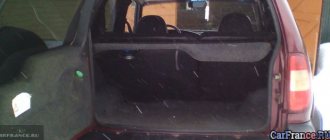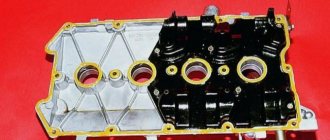How to get rid of creaking stabilizer bushings on Lada Vesta
There are two ways to eliminate the squeak:
- contacting a service station if the car is under factory warranty;
- Do-it-yourself repairs, regardless of whether there is a warranty.
Both methods do not guarantee the disappearance of the annoying sound. The reason lies in the material from which the bushing is made.
In most service stations with a defect using a metal-rubber aerosol. In the best case, they use a Litol type lubricant with the addition of a graphite base.
This “potion” lasts for several thousand miles, after which the sound returns.
The most effective and efficient way is to install non-standard seals from other car brands. It is advisable that the elastic bands are made of polyurethane.
In terms of dimensions and parameters, bushings from:
| Name/items | Price in rubles |
| Chevrolet Niva: articles 2123-2906046, 2123-2906040 | the average cost is from 160 – 170 rubles per piece. Polyurethane ones are 120 – 140 rubles more expensive than analogues |
| Kia Rio: part numbers: KSBSOULF 54813-2K100, 54814-1G000 | cost per set from 800 rubles |
*price indicated as of 03/06/2019.
The principle of operation of stabilizer bushings
The main purpose of the stabilizer, bushings, struts (bones) is to evenly distribute the load along the entire perimeter of the suspension.
The stabilizer is activated when the car enters turns to minimize roll. The bushing is compressed and unclenched in a metal bracket under the influence of pressure from the torsion rod.
Where the body “sags” on its side, the rack raises the frame, and lowers it on the opposite side. The greater the angle of inclination, the stronger the drag force of the suspension.
The main element of the suspension is a torsion bar with sealing bushings at the edges. It is fixed to the suspension, and its edges are connected to the levers.
Conclusion
Despite numerous tips and recommendations, replacing the stabilizer bushings with new ones made of polyurethane remains an effective way. Preferably from a Kia Rio or Chevrolet Niva.
In the first case, additionally buy “native” Korean metal brackets, since the Lada Vesta brackets are not compatible along the external contour. How effective and efficient it is to buy non-original components is up to you to decide, but the quality of the latter has been approved by more than one thousand car enthusiasts.
Which stabilizer bushings are suitable?
As already noted, the original parts are not of high quality. A worthy replacement should be found for them. There are several options to solve the problem:
- Some enterprises are already producing polyurethane bushings for the Lada Vesta stabilizer. This material has better mechanical and chemical resistance than rubber.
- Install stabilizer bushings from KIA on Vesta. These parts fit true to size and are of satisfactory quality. Whether these are original Kia components or analogues does not matter.
Bushings for Kia and Lada Vesta
Both options give good results. Which one to prefer, you will have to decide for yourself. Buying the necessary components is not a problem. But it is not recommended to mount stabilizer bushings from Niva to Vesta. Like original parts, they may be of poor quality.
When purchasing parts from KIA for Vesta, you should make sure that their external and internal dimensions match! Otherwise they may not fit.
Reviews
| № | Positive |
| 1. | Vasily , 34 years old (drive2.ru) Sverdlovsk: for the first time the seals creaked at 20,000 km, I went to the service station under warranty, the guys lubricated it with a metal-rubber aerosol. A year has passed - silence. |
| 2. | Petrovich , 44 years old (prom.ua), Krasnodar: the car is in its third year, no complaints, the suspension is working as normal. I've heard drivers complain about the crunching noise, but I didn't have that problem. |
| 3. | Alexander , 35 years old (autotoday.com), Omsk: I’m happy with the purchase of the Lada Vesta, I regularly visit the service station, I drive carefully, the speed limit is medium. |
| 4. | Ivanovich , 45 years old (rozetka.ua), Rostov-on-Don: my positive review of the Lada Vesta car in general. Good build quality, relatively cheap spare parts, developed network of car services. |
| 5. | Vyacheslavovich , 43 years old, Kursk (avtoflit.com): my first car was a Lada Priora, after which I bought a Vesta. The difference is noticeable in quality, assembly, and service life. Undoubtedly Lada Vesta is better. |
| 6. | Valery , 33 years old, Voronezh (autotoday.com): in three years of using the car, I visited a service station once to replace stabilizer bushings, not counting scheduled technical inspections. |
| 7. | Vasilievich , 46 years old, Ufa (drive2.ru): I take care of the equipment, periodically go to the inspection pit, check the fastenings and components. Over the course of three years, I lubricated the stabilizer bushings several times. I didn't do any more work on the suspension. |
| 8. | Semenych , 38 years old, Bashkortostan (drive2.ru): The Lada Vesta is well assembled, I’m pleased with the quality. I fix minor damage myself. Even when operating on rough terrain, the suspension absorbs bumps perfectly. |
| Negative | |
| 9. | Dmitrievich , 49 years old (prom.ua), Saratov: Vesta disappointed me, after 30,000 km the stabilizer seals creaked. I visited a service station, the guys lubricated it with an aerosol, and after 5000 km the situation with the “sound” repeated itself again. |
| 10. | Alexey , 46 years old, Moscow (avtoflit.com): in two years of using the car, I went to the workshop three times for suspension maintenance. Constant squeaks and crunches. The quality is raw, the machine has shortcomings that the manufacturer must eliminate. |
| 11. | Filippovich , 39 years old, Voronezh (drive2.ru): my opinion is that the Lada Priora was made with better quality than the Vesta. I bought it a year ago and now I regret it. There are a lot of shortcomings, defects, and expensive spare parts. |
| 12. | Valentin , 37 years old, Pskov (autotoday.com): if you are choosing a car between Lada Vesta and Renault Logan, then consider buying a French brand. |
↑ Signs of wear
Over time, an extraneous characteristic noise begins to be heard: it is the stabilizer bushings on the Lada Vesta creaking. This can happen almost immediately after purchase, or the owner will be able to drive 1000-1500 kilometers before having to deal with the causes of the unpleasant squeak. According to inexorable statistics, about 60% of all Vesta copies inevitably suffer from such a defect. According to experts, the root of the problem lies in low-quality components or a violation of their production technology. The further course of events involves the use of several options:
- independent elimination of deficiencies;
- contacting the official representative office of the manufacturer.
Important. The essence of the phenomenon is that the noise occurs in episodes and not constantly, which makes it difficult to localize. Most often, it periodically disappears, only to repeat again.
Calling for service often changes little, since the technicians do not plan to replace the worn bushings of the Lada Vesta stabilizer, but only lubricate them. Therefore, we will have to look for other solutions.
Order of Operations
Important! You can begin repairs if the stabilizer bar is not tense. To do this, the front wheels need to be suspended or the weight of the car is evenly distributed - on a viewing hole or overpass. The place where the work will be performed must be washed.
So, the car is lifted with two jacks or driven into a pit, now you can start working:
- Clean the stabilizer bar fasteners from dirt.
- Completely unscrew the stabilizer link fixing nut and move it to the side. The same procedure must be performed on the other side of the machine.
- There is a cover on the steering system casing that protects it from contamination. It needs to be removed. To do this, five bolts are removed.
Now you can unscrew the two bolts securing the brackets.
The bracket or clamp is removed from its place.
Now you can remove the bushing.
- The rod must be thoroughly wiped, and particles from the old bushing must be removed, especially at the fastening points. The operation is repeated for the second element.
- The rod needs to be rubbed with lubricant so that the new parts can easily fit on it and move easily.
- A new element is installed on the rack.
The bushing moves along the rod to the installation site.
On site, you need to accurately align the bushing along the axis of rotation and fit.
- The same procedure will be repeated with the second bushing.
- Next you need to do the assembly. It is performed in reverse order.
You can also watch the procedure for replacing stabilizer bushings on a Lada Vesta in this video:
↑ Bushings creaking
It will not be possible to determine the defect visually, and it is also difficult to detect it by ear, since the creaking appears and then disappears. Therefore, it is possible for a development of events in which the service specialists, having examined the car and slightly rocked it, “will not notice” any unnatural noises. However, once a defect has arisen, it will not go away, it will not disappear on its own, and effective measures will need to be taken to eliminate it.
Lubrication with a popular spray for metal-rubber contact surfaces is ineffective because it is washed off quite quickly. It is highly likely that the stabilizer rubber bushings will still need to be replaced.
↑ Operating principle of stabilizer bushings
The car suspension, which includes different elements, performs several functions simultaneously: providing comfortable driving conditions on any road, regardless of surface, while maintaining frame rigidity. Some of them perceive and absorb vertical loads, others – transverse ones. The anti-roll bar is designed to distribute forces on the wheel, especially when cornering, in order to eliminate roll.
In its normal state, an elastic piece of rubber either compresses or returns to its standard shape, compensating for unevenness and bends in the track. Loss of properties, excessive rigidity, and destruction of the material can lead to extraneous noise and improper operation of the bushings.
Removing the anti-roll bar elements
We remove the struts and cushions of the anti-roll bar when there is significant wear, cracking, tearing and swelling of the rubber. We carry out the work on an inspection ditch or overpass. Removal of the right stabilizer bar link is shown. The left pillar is removed in the same way.
Using a 17mm spanner, unscrew the nut securing the stabilizer link to the front suspension arm, holding the bolt with a wrench of the same size. Use a soft metal drift to knock out the bolt. To make it easier to remove the strut from the stabilizer bar, unscrew the two nuts securing the stabilizer pad bracket on the right side (as shown below). Lowering the right side of the stabilizer...
...remove the strut from the stabilizer bar. As a rule, on cars with high mileage, worn struts can be easily removed. If the stand cannot be removed immediately, we recommend inserting a thin screwdriver blade between the rod rod and the rubber bushing and pressing out the rubber. After this, a penetrating liquid such as WD‑40 should be injected into the resulting gap and, shaking the strut from side to side, remove it from the stabilizer bar. We install the new rack in the reverse order, having first cleaned the end of the rod and lubricated it with soapy water. To replace the stabilizer bar cushions, unscrew the nuts of the bolts securing the stabilizer bar struts to the arms and remove the bolts.
Using a 13mm socket, unscrew the nuts securing the airbag bracket to the body...
...and remove the bracket. Remove the stabilizer link from the rod (see above).
Remove the cushion from the barbell. As a rule, worn-out pads can be easily removed from the bar, but if there is difficulty...
...cut the pillow with a knife... ...and remove it. We install the new pillow in the reverse order, lubricating the rod and the hole in the pillow with soapy water. We replace the cushion on the other side of the stabilizer bar in the same way. To remove the anti-roll bar, disconnect the stabilizer links from the front suspension arms and remove the stabilizer bar cushion brackets (see above). Remove the anti-roll bar. Install the anti-roll bar in the reverse order.
↑ Replacement Guide
If, nevertheless, a decision is made to replace the stabilizer bushings of the Lada Vesta car, and not half-measures in the form of applying a layer of lubricant to them, which lasts for a limited period of time, then you should decide on the type of components. There is an opinion among motorists that there are analogues for the stabilizer bushings of the Lada Vesta model.
This is true; you can use parts from other machines recommended by experienced craftsmen. Inserts from the Kia and Chevrolet Niva brands are most often cited as being the most compatible with Vesta, close in size and characteristics. How to install them correctly will be discussed further.
How to make a replacement
Replacing the bushings can quite realistically be done only by removing their brackets. To do this you will need a TORX T40 sprocket and a lot of patience.
- The purchased bushings must first be modified by making a slot in the side. In the photo below, the incision site is conventionally shown with an orange stripe.
- Gain access to the front of the vehicle from below. This could be a viewing hole or a lift.
- Unscrew the bolts securing the brackets. One should be unscrewed completely, and the second - all the way to the rail. This will be enough to completely replace the bushings. If you change the bushings to an analogue from KIA, then you can no longer do without removing the rack.
- Place the new bushings on the stabilizer (the cut you made will come in handy here), insert them into the brackets and tighten the bracket bolts.
- Enjoy the quiet and soft operation of the Lada Vesta car suspension.
We invite you to watch a video of one of the car enthusiasts who encountered a problem and solved it by replacing the bushings with analogue ones.
↑ Dismantling old
The dismantling process is preceded by the selection of suitable stabilizer bushings for the Lada Vesta in order to replace worn ones. There are several options for the details themselves:
- spare parts from Niva;
- inserts “Kia”, “Hyundai”;
- products made of polyurethane (characteristic yellow color).
Important. Korean components will cost more than Niva components, but, in any case, before making a purchase decision, you need to study the assortment and prices of auto markets and online sites: the difference in sellers’ offers can be significant.
The opinion has been repeatedly expressed that spare parts from the Chevrolet Niva can also cause squeaking, but, unfortunately, this can only be confirmed by replacing old components with them. Before dismantling begins, the machine is driven onto an inspection platform, after which, armed with a previously prepared tool, they begin to remove worn parts.
When is it necessary to replace stabilizer bushings on a Lada Vesta sedan and why?
If you notice any deformation of the steel rod, you should immediately straighten it or install a new one. Wear of rubber cushions, regardless of the type of Vesta gearbox , is characterized by the following symptoms:
- Extraneous noise or creaking in the front suspension area.
- The appearance of a squeak when driving over uneven surfaces or after overcoming a water obstacle.
- Deterioration in the quality of driving at speeds of 60-90 km/h.
If one of the signs appears, the condition of the pillows should be checked visually. Any swelling or cracking of the rubber is unacceptable. It would be a good idea to pay attention to the SPU racks, which themselves are very often sources of creaking due to the appearance of play in the connections.
The manufacturer claims that the resource of rubber cushions is enough for 25-30 thousand km. But practice shows completely different gaps. I've heard that some car owners replace stabilizer bushings on their Lada Vesta after the first thousand. However, repairs cannot be postponed, no matter at what stage it happens, because the condition of the front suspension directly affects the car's handling.
Which pillows are suitable for SPU Lada Vesta?
A certain proportion of motorists limit themselves to silicone lubricant, which is used to treat the pillow. In fact, AvtoVAZ itself recommends using a similar method in car service centers. It is likely that it will help at the first stage, but if there are serious defects, it is at least unreasonable to talk about lubrication - the part must only be replaced.
It is better to replace standard rubber bushings with products made of polyurethane; their catalog number is 17012680. The internal diameter of the original bushing is 21.5 mm. In addition, it is possible to use several more details:
- Polyurethane cushions from Chevrolet Niva 2123 with article number 17012680.
- Rubber bushings and metal brackets from KIA Rio with article numbers 548132K100 and 548141G000, respectively.
↑ Installation of new
Essentially, this is the reverse process of removing the old stabilizer bushings. But in reality, everything turns out to be a little more complicated: the analogues do not always match in size with the “native” parts of the Lada Vesta, it is quite possible that to adapt them you will have to use the widely known “method of modification with a file” among the people.
To do this, you need to have confidence in your own abilities, or you will have to contact specialists at the nearest service center. Searching by article number for the stabilizer bushing on the Lada Vesta will help if you have an understanding of what the part looks like in real life. There are several different options, for example, higher inserts from Chevrolet or from Kia, with a pressed-in clamp. “Nivovsky” parts are ground down to reduce their height, then a special slot is made in them.
Korean ones most often coincide in dimensions with Western ones, but may differ in the method of fastening. To avoid future problems and questions about which stabilizer bushings are suitable for the Lada Vesta, it is best to select a replacement with the removed part in hand - the method is old, reliable and time-tested. The new rubber band must fully match the dimensions of the old one, including fasteners.
Therefore, you should check with the seller in advance (especially if we are talking about expensive Korean analogues) how to secure the bushing. This smart approach will eliminate the need for repeated visits to the store, ordering additional items or exchanging purchases.
Important. Compatible spare parts can exist in 2 versions: with pressed-in eyes for installation and mounted on a clamp. Both options should be worked out in advance by talking with the salesperson at the auto parts store.
As a rule, the success or failure of the operation will quickly manifest itself: if after 1-1.5 thousand kilometers the noise does not recur, it means that the installation of new components was justified. Otherwise, you will have to start the quest again to select high-quality shock-absorbing liners.
This is why the process of initially determining compatibility (and originality) is so important: you will not need to re-purchase elastic bands and go through the hassle of installing them.
Stabilizer bushings for Lada Vesta. Why do we creak?
Since the problem of squeaking stabilizer bushings on the Lada Vesta has become widespread, the manufacturer had to somehow respond to this.
That's what AvtoVAZ did. The press center said that they are aware of the problem of bushings squeaking and in the near future they will make every effort to make the annoying squeaks disappear. No one knows what VAZ is going to do, but it is a fact that the bushings squeak even on a car produced in 2018. Therefore, apparently, the owners themselves will again have to deal with everything. The reasons why the Vesta stabilizer may creak are not a military secret and are familiar to anyone who attended physics classes at school and is familiar with the design of the anti-roll bar. On Vesta, it is no different from other budget cars and works as a torsion bar between the right and left suspension arms. The peculiarity of any torsion bar that works in torsion is that to control its operation it is necessary to have at least three attachment points. The first is the stabilizer link, which in turn is attached to the lever. The second is the support point, this is the stabilizer bushing. The third is the opposite side of the stabilizer. Since we have two support points, the stabilizer is ultimately fixed at the ends of the stabilizer struts and on the beam using bushings.
Layout of anti-roll bar bushings
The size of the bushings must be selected in such a way that the stabilizer is able to work in torsion. It should not be tightly clamped, but it should not be too loose. In the first case, we provoke huge extra loads on the suspension elements; in the second case, the meaning of using an anti-roll bar is lost.
Here the second requirement for bushings comes up - they must be made not only in size, but also from a material that makes it possible to tightly hold the body of the stabilizer, but make it possible to move its ends within certain limits independently of each other.
Conclusions We draw conclusions about why the stabilizer creaks on the Lada Vesta:
- The dimensions of the stabilizer bushing do not correspond to the diameter of the stabilizer and the dimensions of the clamping clamp.
- The stabilizer bushing clamp does not match the dimensions of the bushing.
- The bushing material is selected incorrectly and does not ensure independent movement of different ends of the stabilizer without rotation inside the bushing.
- The stabilizer bushing brackets are loose.











